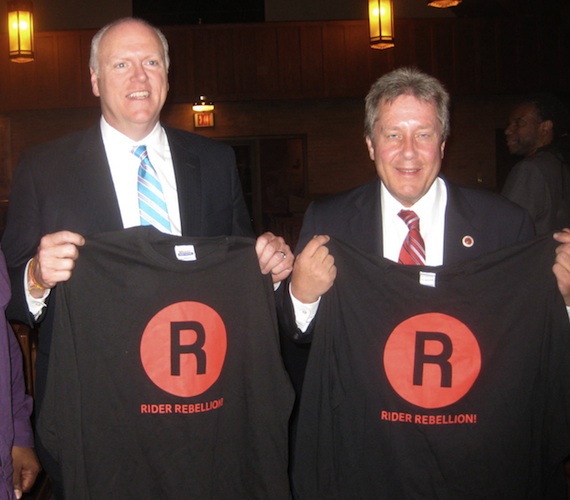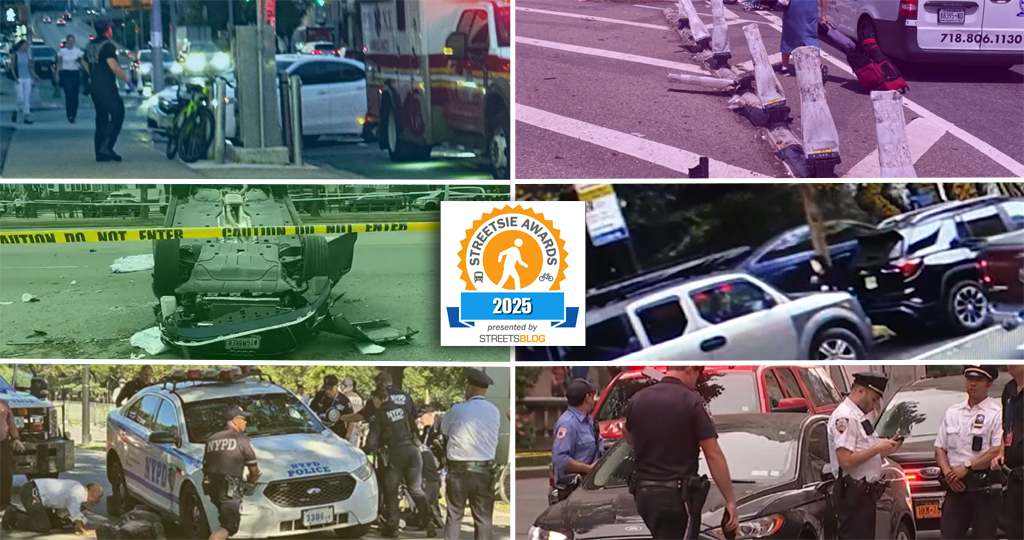
Elmhurst's elected officials voiced support for transit investment at a town hall hosted by Congressman Joe Crowley and Council Member Daniel Dromm last night.
A group of politicians including the two hosts, State Senator Toby Ann Stavisky, and Assembly Members Grace Meng and Francisco Moya called for reopening Elmhurst's Long Island Railroad Station, shuttered in 1985 due to low ridership. And to help bus and subway riders across the city, Elmhurst's reps said the state would need to find new, dedicated revenue for transit.
Underlying the entire evening discussion was Elmhurst's explosive population growth, fed by a vibrant immigrant community. The population of Elmhurst and the surrounding neighborhoods of Corona, East Elmhurst and Jackson Heights grew 40 percent between 1980 and 2010, and many believe recent estimates for the area are too low. "Elmhurst continues to grow and multiply," said Crowley, "but we have still been limited to the same modes of transportation."
Residents complained of crowded buses and leaky subway stations, demanding more investment in their neighborhood. Just under half of subway riders interviewed by Transportation Alternatives at a nearby station said they had a one-way commute of 45 minutes or more.
Crowley, who also serves as head of the Queens Democratic Party, said that more and better transit has to be part of the solution for the neighborhood. "It's about more livable communities, places that provide access to people," he said. "It's about finding smarter ways to move people about."
"You can't run a city like New York City unless you have a high-quality mass transit system," agreed Dromm.
Previous transit town halls have taken place in Flushing, Jamaica, and Soundview. Much of the evening's discussion focused on the effort led by Crowley and Dromm to reopen the neighborhood's LIRR station, located on Broadway near Whitney Avenue. "The people are here," said Stavisky. "They're ready to use the railroad."
Though reopening the station would cost $30 million, according to the Daily News, and LIRR fares are significantly costlier than the subway, Crowley argued the money would be worth it for many residents headed into Manhattan. "What is the cost of freedom?" he asked. "What is the cost for an extra forty minutes or an hour? What would one pay to have that extra hour with their children?"
A representative for the LIRR expressed enthusiasm for the possibility of reopening the station after the completion of the MTA's current capital plan in 2014; he said improvements currently being built would be necessary to ensure that trains stopping in Elmhurst weren't already full once they arrived.
He also said that the station would have elevator access to the platforms, which earned acclaim from the largely older population attending the meeting. "From here to Mid-Manhattan is an hour and twenty minutes at least," said one Elmhurst resident who currently has to take the bus because she is in a wheelchair. "I do it three times a week." Added her friend, "If you build it, we will come."
While the politicians didn't endorse a specific revenue source to pay for the changes, they knew that Elmhurst won't get something for nothing. "That's why finding ways to raise additional funding for the MTA to make improvements, for the Elmhurst station, for any of the subway lines, in reality, is so important," said Dromm. "Without some source of dedicated funding, we're going to see more neglect, unfortunately."
In response to a question about where those revenues could come from, Transportation Alternatives Executive Director Paul Steely White rattled off a number of options, including raising the more than a dozen taxes that already go to the MTA, reinstating the city's commuter tax and putting that money toward transit, or Sam Schwartz's plan to rationalize the city's toll system -- lowering tolls on outlying bridges while adding tolls to the currently free bridges into Manhattan.
"The most important part is finding alternative resources so we can invest and reinvest in our mass transit system," said Crowley. He didn't endorse a particular revenue stream, but said that White's list included a number of potential options.
The congressman also noted that in addition to finding new revenues, the MTA needs to hold on to those it has from the federal government. The Republican proposal for a transportation bill, which Crowley fought against, could have cost the MTA up to a billion dollars a year by eliminating the share of gas tax revenues going to transit. "We need to not cut," he said. "I know that the Senate is working on a two year extender at the current levels, which is not optimum but is better than what they were doing in the House." Crowley said he was hopeful that Congress would pass a transportation bill this year, but that he wasn't holding his breath.
Meng, who along with Stavisky also attended the transit town hall in Flushing last summer, spoke passionately about the importance of transit. "For the future and success of the Queens economy, I think mass transit is vital," she said. She noted that many of her constituents see building more parking as the best way to improve transportation, but investing in transit was a better idea.
Moya pitched transit improvements as a way to improve the ever-worsening congestion on Queens streets. "We need to find a solution to how we can ease a lot of the traffic that we're seeing throughout the communities. So many people travel by car," he said, "because of the lack of a train."





